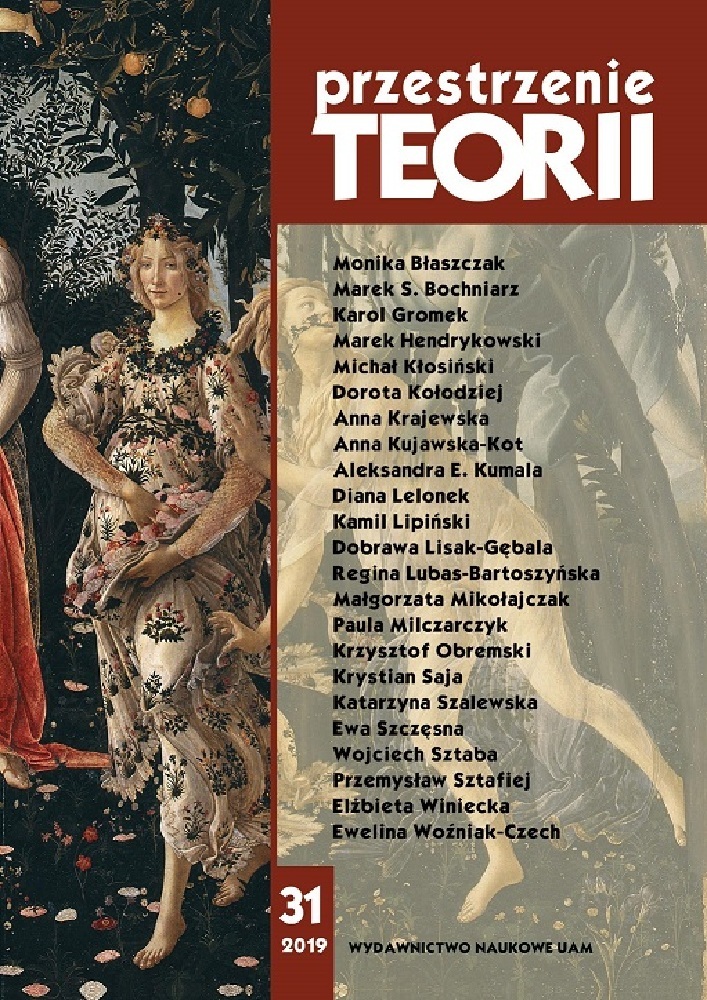Abstrakt
In this paper, I analyse the phenomenon of artification of everyday experience. Using the concept of “artification” developed in the field of Everyday Aesthetics, I define the non-artistic experience, which is co-shaped by art and related to its models of perception. As the consequence of this mechanism, I indicate the tendency to project some artistic cognitive schemas (or their elements) to the existing reality. As a result of this process, events and non-artistic views are captured in the image of art, as ”art-like”. The process of the interpenetration of the fields of art and non-art may lead in turn to the reversal of the mimetic order – when artistic creation determines the forms of examining the world to the extent that it creates the effect of “life imitating art”. This phenomenon of formalizing experience according to artistic models is illustrated by examples from the linguistics, visual arts and literature.
Bibliografia
Berleant A., Prze-myśleć estetykę. Niepokorne eseje o estetyce i sztuce, przeł. M. Korusiewicz, T. Markiewka, Kraków 2007.
Berleant A., Wrażliwość i zmysły, przeł. S. Stankiewicz, red. K. Wilkoszewska, Kraków 2011.
Bubner R., Doświadczenie estetyczne, przeł. K. Krzemieniowa, Warszawa 2005.
Capote T., Psy szczekają, przeł. B. Zieliński, Warszawa 1982.
Danto A.C., Świat sztuki. Pisma z filozofii sztuki, przeł. L. Sosnowski, Kraków 2006.
Dissanayake E., Hipoteza artyfikacji i jej znaczenie dla kognitywizmu, neuroestetyki i estetyki ewolucyjnej, „Kultura – Społeczeństwo – Edukacja” 2015, nr 2 (8).
Docherty T., ANTI-MIMESIS: The Historicity of Representation, „Forum for Modern Language Studies” 1990, vol. XXVI, is. 3, s. 272–281.
Eco U., Semiologia życia codziennego, przeł. P. Salwa, J. Ugniewska, Warszawa 1996.
Featherstone M., Postmodernizm i estetyzacja życia codziennego, przeł. P. Czapliński, J. Lang, [w:] Postmodernizm. Antologia przekładów, red. R. Nycz, Kraków 1997.
Gołaszewska M., Estetyka o orientacji empirycznej, [w:] Estetyki filozoficzne XX wieku, red. K. Wilkoszewska, Kraków 2000.
Gołaszewska M., Estetyka rzeczywistości, Warszawa 1984.
Gołaszewska M., Potoczna sytuacja piękna, [w:] Estetyka codzienności, red. J. Chłopecki, A. Horbowski, Rzeszów 1988.
Hłasko M., Piękni dwudziestoletni, Warszawa 1995.
Kaprow A., Essays on the Blurring of Art and Life: Expanded Edition, ed. J. Kelley, Berkeley 2003.
Kosiński D., Historioni i aktorzy, „Ethos” 2007, 77–78, s. 135–146.
Leddy T., The Extraordinary in the Ordinary: The Aesthetics of Everyday Life, Peterborough 2012.
Mandoki K., Everyday Aesthetics; Prosaics, the Play of Culture and Social Identities, Aldershot 2007.
Marquard O., Aesthetica i anaesthetica. Rozważania filozoficzne, przeł. K. Krzemieniowa, Warszawa 2007.
Naukkarinen O., Variations in Artification, „Contemporary Aesthetics”, Special Issue 2012, 4.
Pękala T., Awangarda i ariergarda. Filozofia sztuki nowoczesnej, Lublin 2000.
Saito Y., Everyday Aesthetics, New York 2007.
Welsch W., Estetyka i anestetyka, przeł. M. Łukasiewicz, [w:] Postmodernizm. Antologia przekładów, red. R. Nycz, Kraków 1997.
Licencja
Autorzy
Autorzy tekstów przyjętych do publikacji w czasopiśmie „Przestrzeniach Teorii” są zobowiązani do wypełnienia, podpisania i odesłania na adres redakcji umowy o udzielenie nieodpłatnej licencji do utworów, z zobowiązaniem do udzielania sublicencji CC.
Zgodnie z umową, autorzy tekstów opublikowanych w czasopiśmie „Przestrzeniach Teorii” udzielają Uniwersytetowi im. Adama Mickiewicza w Poznaniu niewyłącznej i nieodpłatnej licencji oraz zezwalą na użycie sublicencji Creative Commons Attribution-NonCommercial-NoDerivatives 4.0 International (CC BY-NC-ND 4.0).
Autorzy zachowują prawa do dalszego, swobodnego rozporządzania utworem.
Autorzy, którzy wykorzystują w swoim tekście cudze utwory (np. ilustracje, fotografie) proszeni są o dostarczenie do redakcji czasopisma zgodę na publikację od uprawnionych podmiotów.
Użytkownicy
Zainteresowani użytkownicy internetu uprawnieni są do korzystania z utworów opublikowanych po 2015 roku „Przestrzeniach Teorii” tylko w calach niekomercyjnych, pod następującymi warunkami:
- uznanie autorstwa - obowiązek podania wraz z rozpowszechnionym utworem, informacji, o autorstwie, tytule, źródle (odnośniki do oryginalnego utworu, DOI) oraz samej licencji;
- bez tworzenia utworów zależnych - utwór musi być zachowany w oryginalnej postaci, nie można bez zgody twórcy rozpowszechniać np. tłumaczeń, opracowań.
Do wszystkich tekstów opublikowanych przed 2015 r. prawa autorskie są zastrzeżone.
Inne
Uniwersytet im. Adama Mickiewicza w Poznaniu zachowuje prawo do czasopisma jako całości (układ, forma graficzna, tytuł, projekt okładki, logo itp.).

